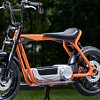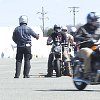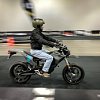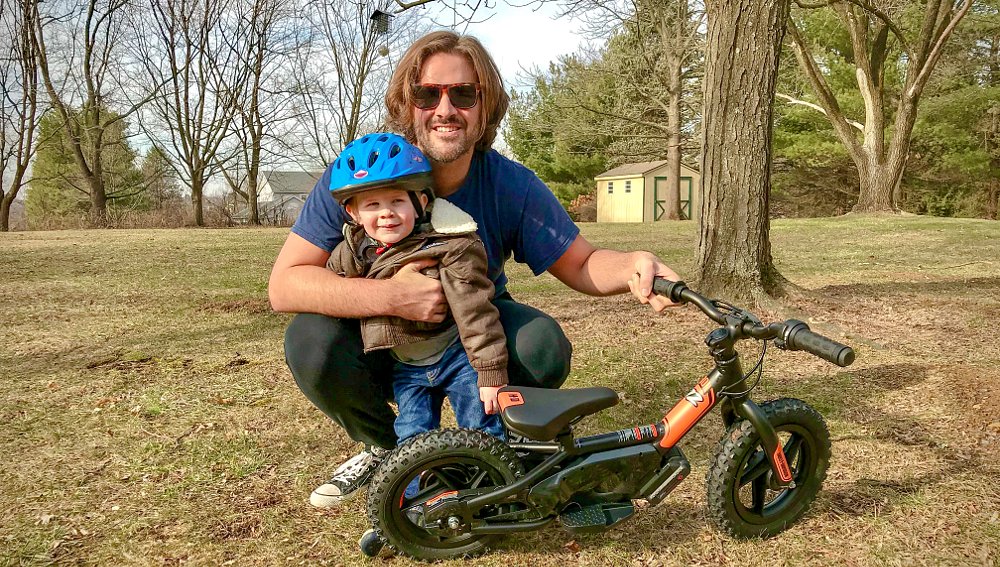Harley-Davidson recently announced big changes to its rider education programs. “We’re on a mission to make it easier than ever for you to get on a bike, build your skills and gain the confidence you need to ride,” reads Harley’s new personal coach finder.
In the past, Harley’s classes closely resembled courses taught through the Motorcycle Safety Foundation. A handful of instructors and a class of students spent time in the classroom and on the range with a fleet of hardy loaner bikes until everyone learned the basics. The classes took place on a predetermined schedule and classes were typically spread out over a few evenings or weekends. In contrast, H-D’s three new programs are less conventional and more personalized. (It seems they'll keep offering the old program, too.)
Here's what the new offerings look like.

Experience the Ride ($25-$120)
Experience the Ride is a 90-minute intro to motorcycles aimed at "those who have never been on a motorcycle but are looking to try it out with a low pressure, low commitment experience" and “those who are looking for an experience to learn if riding is right for them and alleviate anxiety about getting on a motorcycle before taking formal rider training.” By the end, students will ride from one side of the range to the other with their feet off the ground. Motorcycles, helmets, and gloves will be provided. (Probably Street models, although the site didn’t say.) The only things students need to bring are long pants, a shirt/jacket with long sleeves, boots that cover the ankles, eye protection, and some friends if you’ve signed up together.
Learn to Ride ($75-$200 per module, four modules total)
If you’re looking to get your license, Harley would steer you towards the Learn to Ride program for “future riders looking to learn all the skills necessary to earn your motorcycle license… You can complete this program 1-on-1 or in private groups ranging from 2-4 in size.” Learn to Ride encompasses four modules, each about four hours long. After successfully completing Learn to Ride, some states will give riders their motorcycle licenses. Learn to Ride sounds very similar to the MSF course, aside from the scheduling and the class sizes. Harley does ask that riders complete all four modules at the same dealership within three weeks.
Master the Streets (No price given)
Armed with licenses and new bikes, or maybe rentals, some newly minted motorcyclists will set off into the sunset and ride happily ever after. Others might have more questions, or maybe they just want a riding mentor for the first few trips on actual roads. Harley’s Master the Streets program is intended for “newly licensed riders seeking assistance with continuing their rider journey.” They can use the dealership’s resources and experienced riders to answer questions, size riders for gear, set up test rides, and more. No additional training happens here; it’s more of a follow-through effort to keep supporting riders who’ve passed through the other two programs.
At the time of writing, these options are available at select dealerships in Florida, Georgia, and Texas.
Harley’s three programs don’t look like traditional rider education. For an expert’s take on Harley’s ideas, I reached out to Robert Pandya, who heads up the Discover the Ride events at the International Motorcycle Shows. We featured Spurgeon's excellent interview with Pandya back in March. I wanted to see what someone who is dedicated to helping new riders get started would think of Harley-Davidson's approach.
Overall, Panyda saw great promise in Harley’s programs. “Broadly speaking, I definitely applaud H-D for taking a new look at exploring motorcycling for new riders. It’s needed attention for a long time. As the most recognized motorcycle brand in the western world, it’s Harley’s job to do that, and every other brand should look at emulating any success Harley sees with these programs,” he told me on a call. “Personally, I have to reserve any judgment on the quality or substance of the programs until I see them in person. But I believe that they’re doing a really good thing in rethinking what I’ll call pretraining, or first experience management.”
Andy Greaser: Discover the Ride put thousands of brand-new riders on modified electric bikes at IMS and showed them the ropes. What did your first experience management look like there?
Robert Pandya: I focus on making training more approachable. That’s 100 percent the theory of Discover the Ride. We did that thousands of times, and very successfully. We proved to the industry that there are ways to create motorcycling experiences that are not as intimidating as traditional training courses with multi-day commitments and, in many states, several hundred dollars.
If you know how to ride and balance a bicycle, we just needed 10 minutes and the right tool to get somebody on a motorcycle. Granted, a speed-limited, twist and go, ABS-equipped motorcycle, but a full-size motorcycle to be sure.
AG: What challenges will Harley face as they get these programs going?
RP: Well, the instruction seems to be about high quality, not volume, so that is incumbent on having a lot of instructors available. I’ll let them worry about the logistics of that. The programs are going to be at a limited number of dealerships, in a limited region, and they’re not starting in most of the big population centers of this country. Starting small should help them develop a larger, stronger program, as long as they keep moving forward and don’t lose momentum.
If you read the fine print on the Personal Coach Finder: Powered by Harley-Davidson site, you’ll find... they’re working with a third party to deliver the instruction. That’s not a bad thing. It does mean that they’ll need to maintain a very close relationship with their trainers if they want to be successful.
There’s another challenge that any program like this would face. When there are fewer students, or only one student, you’re going to be missing that feeling of community that comes with a larger group. Community and culture are huge for Harley. You have less of that with this student-teacher ratio. In a pandemic world, hanging out with people is not that appealing anyway, so that’s a fair thing to give up right now to favor a higher quality training program.

AG: Outside of the obvious problems that come with the pandemic right now, what challenges are potential riders facing?
RP: The hardest part for most new riders is mastering the clutch. When you add turning and clutch, like taking off from a stop to turn onto a larger road, that’s scary when you’re new! Early instruction without clutches would fundamentally change training for all brands.
AG: Now, I don’t want to make you tell a manufacturer what to do…
RP: Oh, I want to do that all the time! [laughs]
AG: ...but if you were in charge of Harley’s new programs, what would you do?
RP: If I was the manager of these programs, I’d roll them out in a small test area, and then once Harley’s full-size ebikes come out, I’d be able to do what we did with Zeros for Discover the Ride. It took us five minutes of modification to make the bikes super friendly.
The 90-minute experience in particular can easily be an overall positive experience without a lot of commitment. That’s exactly what every manufacturer should be doing right now. Honda could do this with the semi-automatic Super Cub, right? Put it in first, remove the shifter, and use some mechanical stop to limit the top speed. Just make it approachable. If you're a newbie, it gives you that little breath of confidence that says, “You can sign up. You can do this.” People just need that one brain cell to light up. I think Harley’s smart to have the programs at dealerships, where they’re creating these one-on-one, personalized scenarios, and then setting people loose in showrooms to fantasize about motorcycles.

AG: What are some lessons you learned from the Discover the Ride program that might apply here?
RP: A huge reason why DTR was so successful was using direct-drive bikes. I can’t stress it enough: no clutch for that very first encounter. You learn to ride straight and turn left. H-D’s program might be complicated by a standard hand clutch, since I’m guessing they’ll start with Street 500s. I’d expect them to get entry-level electrics into these programs as soon as possible.
From a standpoint of approachability, this industry is seriously lagging. If you go into a gun store and you don’t know what you’re talking about, whoever’s behind the counter will guide you to a .22 and some training. Training is part of their religion in shooting culture. That experience has to be in motorcycling where there’s a safe taste-testing opportunity with appropriate equipment. I hope it’s part of a larger expansion of training.

AG: Any thoughts on what the future of these programs will be?
RP: I’ll be interested to see where this goes for Harley. I think they’ve caught some elements of what we’ve been seeing with DTR. You can really highlight the positives of riding with one-on-one or one-on-four programs, and instructors don’t have to train to the lowest common denominator of a large class. It’s so much more personal, and the pacing and time commitment can be more flexible, which the MSF is not particularly.
Next steps for Harley? Be fairly transparent about the work, and how it’s going. Humanize the programs as much as possible. Outside of the PR-happy-millenial shots, there’s not much of a sense of real people yet. Get some more video and real testimonials in there from the new programs so people can visualize themselves in the same scenario, learning to ride.
Then expand to more dealerships. The downside of a low student-teacher ratio is there needs to be more of it, and the work for the instructor is pretty exhausting. You could do, what, two 90-minute classes in a morning and three in an afternoon? That’s a pretty intense day. Expanding that and having strong training for the educators will be key.
If they can switch to electric, everything gets so easy. Those 90 mins will be so productive. We had folks in moto gear and riding in minutes, doing laps at IMS for their first rides ever. If Harley would get so progressive as to work with, say, Rekluse clutches in the Street 500s, they could offer an auto-clutch bike and 15 percent throttle with very little effort. If they can do something like that, this’ll be hugely successful. You really don’t have to do anything but give a positive first experience. Just the proven old model of widening the funnel.
Harley's not alone
In fairness, Harley certainly isn’t the only OEM with an interest in training. Honda operates four Rider Training Centers in the United States, and their motorcycling PR media coordinator, Colin Miller, says they teach over 5,000 riders annually. The courses closed due to the virus earlier this year, but they’re open again with limited class capacities and new health and safety guidelines. Honda teaches both on- and off-road riding skills classes at the training centers. When I visited their facility in Colton, California, Honda’s efforts felt well-established and approachable. I don’t think Team Red will stop training new motorcyclists any time soon.
H-D’s quest for more riders spans no small number of models, initiatives, and leaders. How can they get more people interested in riding Harleys? How can they get more people interested in riding, period? Harley hopes their three new programs will better position their brand to meet tomorrow’s riders and the intimidation they feel from motorcycling. Pandya certainly thinks there’s a chance.













